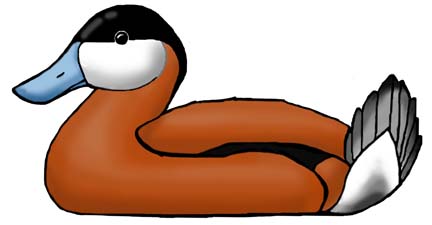

They breed in western Canada and the U.S. from the Great Lakes westward and from central Canada down to Texas. They winter in the U.S. on the coasts and south into Mexico and Central America. They have been introduced to Europe and their range is spreading.
They breed on ponds, lakes and marshes (freshwater) as long as there is cover (vegetation for hiding).
Males are larger and much more striking than the females (sexual dimorphism) with a reddish-brown neck and body and dark tail that they hold upright like a fan. They have a white face and black cap and a powder blue bill that widens at the end. Their legs are set far back on the body which makes them excellent swimmers but clumsy on land.
Ruddy ducks are excellent divers and use their skill to forage on the bottom for food. They can also sink into the water to hide from predators. They are often seen alone or in small groups, but rarely mix with other species.
They are omnivores feeding on plant matter and invertebrates (insects and insect larvae) that they sift out of the mud at the bottom.
Females build a nest just above the water line and build a plant matter dome over it to hide it from predators. Then she lays up to 10 large, white eggs and incubates them for about a month. Hatchling can leave the nest within days of hatching but the female will stay with them for the next 3-4 weeks.
Kingdom: Animalia
Phylum: Chordata
Class: Aves
Order: Anseriformes
Family: Anatidae
Subfamily: Oxyurinae
Genus: Oxyura
Species: O. jamaicensis
When you research information you must cite the reference. Citing for websites is different from citing from books, magazines and periodicals. The style of citing shown here is from the MLA Style Citations (Modern Language Association).
When citing a WEBSITE the general format is as follows.
Author Last Name, First Name(s). "Title: Subtitle of Part of Web Page, if appropriate." Title: Subtitle: Section of Page if appropriate. Sponsoring/Publishing Agency, If Given. Additional significant descriptive information. Date of Electronic Publication or other Date, such as Last Updated. Day Month Year of access < URL >.
Amsel, Sheri. "Duck (Ruddy)" Exploring Nature Educational Resource ©2005-2024. December 14, 2024
< http://www.exploringnature.org/db/view/245 >

